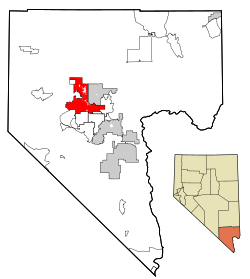Las Vegas
Las Vegas is a city in the American state of Nevada. The city had an estimated population of 632,912 people in 2016. It is the biggest city in Nevada. Las Vegas is also the county seat of Clark County in Nevada.
| City of Las Vegas | |
| 250px | |
 Location of the city of Las Vegas within Clark County, Nevada | |
| Country | United States |
| States | Nevada |
| Settled | May 15, 1905 |
| Incorporated (city) | March 16, 1911 |
| Seat | Clark County |
| Population (2010) | |
| • City | 583,756 |
| • Urban | 1,314,356 |
| • Metro | 1,951,269 |
| (30th most in the U.S.) | |
| Website | www |
History
Mormon farmers first lived there in 1854. The city is known for its dry climate, as is the rest of southern Nevada. It is surrounded by deserts.
Spanish traders traveling to Los Angeles along the Spanish Trail were searching for a path that could make it easier for them, such as one with a good water supply. At the time, traveling to Los Angeles was very difficult, since it involved passing through the very hot and dry desert. A Spanish scout named Rafael Rivera was the first person of European ancestry to discover what we now call Las Vegas. His discovery of a valley full of wild grass and an abundant water supply was just what they needed to shorten the trip. The valley was named Las Vegas, which is the Spanish language word for The Meadows.[1]
In the mid 1800's a lot of precious metals, like gold were discovered in Las Vegas. This lead to a growing mining industry and economy. A railway was also built during this time that linked Southern California with Salt Lake City, making Las Vegas a railroad town. Las Vegas had lots of water making it an ideal rest stop and refueling point.
During the Late 1800’s The State Land Act of 1885 offered sections of land at just $1.25 USD per acre. Farmers quickly moved in and agriculture becomes an important industry for the city. The US Army built Fort Baker there in 1864. Las Vegas has springs so people used to stop there for water when they were going to Los Angeles or other places in California.
In 1905, 110 acres owned by William A. Clark, on which he built a railroad to Southern California were auctioned and Las Vegas was founded as a railroad town. Las Vegas officially became a city in 1911. The population was about 3,300 at the time. Gambling was also legalized during this time. Marriage and divorce laws were more relaxed too, so that brought in more visitors. Early short-term stays that would later become hotels were starting to appear.
In 1931 the construction of the Hoover Dam brought in a lot of new construction workers and increased the economy that at the time was still feeling the impact of the Great Depression. After the Hoover Dam was completed the population grew to 8,422.
World War II started a new defense industry. Their remote location in the desert with plentiful water and inexpensive energy made it perfect for military use.
In the 1940's following World War II, decorated resort hotels and gambling casinos providing big-name entertainers came into existence. Tourism and entertainment took over as the single largest employer in the city.
The “Welcome to Fabulous Las Vegas” sign is created by Betty Willis in the 1950's. At that time Las Vegas encompassed 25 square miles and had a population of 64,405.
During the 1960s Howard Hughes and other corporations began building new hotel and casino properties.
Starting in the mid 1980s the city had a huge amount of growth and nearly doubled in size to over 368,0000. 10 years later they would grow to over a million residents.
From 2000 to present, many new hotels were built and old ones demolished. Steve Wynn opened a hotel name after him. CityCenter was formed with the Aria, Vdara and Cosmopolitan hotels.
Culture
Las Vegas, also known by a shorter name, Vegas, is notable for its liberal policies on activities such as drinking and gambling. Gambling was made legal in the state of Nevada in 1931. In 1941, many hotels were built in Las Vegas with casinos in them. Las Vegas is sometimes called "Sin City" because so many people come to the city for gambling and drinking alcohol, two common "sins".
People come to Las Vegas for vacation, many hotels have different themes and have shows and events to get people to come there. Because of this, Las Vegas is called "The Entertainment Capital of the World".
Las Vegas is also known for its many casinos, decorated with various bright colours. Some casinos include Caesars Palace, a Roman Empire themed casino, Bellagio, a Bellagio, Italy themed casino, Paris Las Vegas, a Paris themed casino, Monte Carlo Las Vegas, a Monte Carlo, Monaco themed casino, and New York New York, a New York City themed casino. The city of Las Vegas is in downtown Las Vegas. People who visit Las Vegas in the Las Vegas Strip are mostly in Paradise, Nevada, the other is in Winchester, Nevada not in the city of Las Vegas.
Images
Other websites
| Wikimedia Commons has media related to Lua error in Module:Commons_link at line 62: attempt to index field 'wikibase' (a nil value).. |
| Website |
|---|
| Las Vegas with Kids: Hotels and Attractions. |
| Official Las Vegas Tourism Site |
| Official Government Site |
| Las Vegas History |
| Kids in Vegas Guide |





